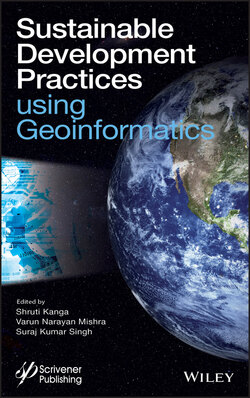Читать книгу Sustainable Development Practices Using Geoinformatics - Группа авторов - Страница 33
2.4 Result and Discussion 2.4.1 Thematic Layers of GHI 2.4.1.1 AOT, PWV, and Temperature
ОглавлениеThe ground-based concentration of AOT, PWV, and temperature were simultaneously measured at 41 locations using the MICROTOPS-II Sunphotometer instrument during January 2011. Further, measured datasets were spatially analyzed using GIS to identify the geo-environmental condition of the study area (Figures 2.3a–c).
An aerosol is one of the primary pollutants that affect air quality in urban as well as the rural environment of the world [29]. Various coal mining activities such as mine fire, overburden dumping, transportation, and other anthropogenic activity are responsible for increasing these types of pollutants in the atmosphere. The spatial distribution map of AOT(340 nm) indicates a higher concentration (>1.5) over industrial areas (Bhurkunda, Chaingada, Jindal Steel and Patratu thermal power station) followed by active mining regions (Potonga, Railgada, Sayal, Giddi-C, and Bhurkunda colliery). Higher frequency of transportation activities, loading/unloading of coal, smoke emissions from power plants, and sponge iron factories are the primary cause for dispersion of dust particles into the atmosphere in the area (Figure 2.3d). Whereas AOT is lower in the residential and vegetation areas (<0.6). The range of aerosol concentration in the study area is between 0.46 and 2.42 (Figure 2.3a).
Figure 2.3 Map showing spatial distribution of (a) AOT at wavelength of 340nm, (b) PWV, (c) temperature, (d) field photographs showing emissions of gases from various sources.
Water vapor has a significant relationship between various components of the hydrological cycle. The PWV is an important parameter of water vapor, which is a measure of the total water vapor contained in a small vertical column extending from the ground surface to the top of the atmosphere. However, the majority of moisture in the atmosphere is contained approximately within the lowest 10,000 ft. Distribution of PWV is a good indicator of the dynamics of circulation systems in the atmosphere. It is also an imperative physical parameter for characterizing the optical properties of atmospheric aerosols that influence the global radiation budget and climate change. At present, PWV is also measured using MICROTOPS-II Sunphotometer of solar intensity at 936 and 1,020 nm. The PWV in the study area exhibits a range of 0.3 to 1.7 cm (Figure 2.3b). It shows variation with high values in industrial areas and low values in forest areas. The high value in industrial areas shows that the humidity near industrial areas is higher as compared to the coal mining, forest, and urban areas.
Surface temperature is also playing a major role in increasing AOT in the atmosphere. During day time, temperature over the study area in the winter season varies between 12.3°C and 29.5°C (Figure 2.3c). There are some surface mine fires present in this region, which is responsible for increasing the average temperature of the area (Figure 2.3d). The present study revealed that the temperature is found to be higher in the vicinity of industrial areas as compared to the mining, urban, and forest area (Figure 2.3c).
